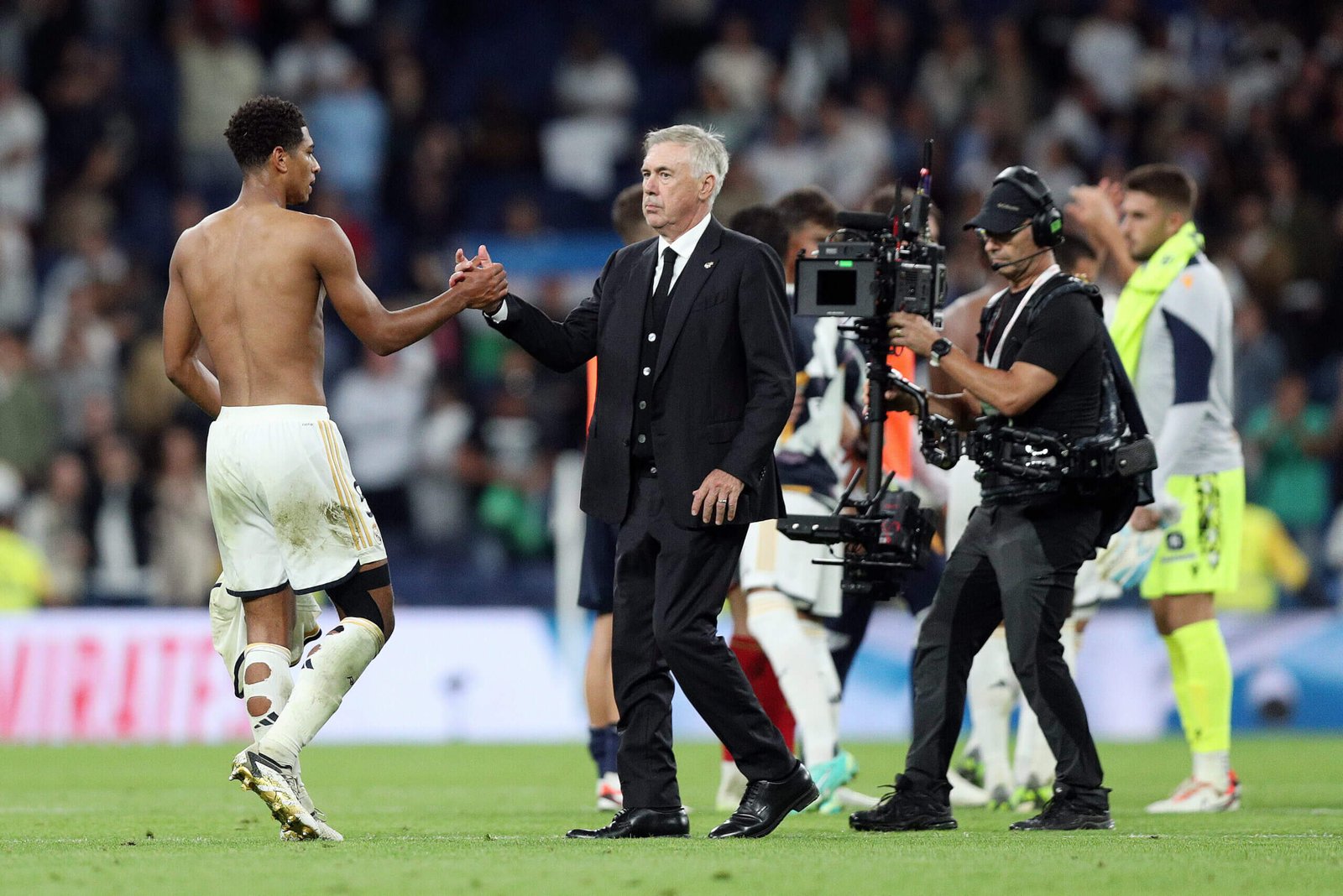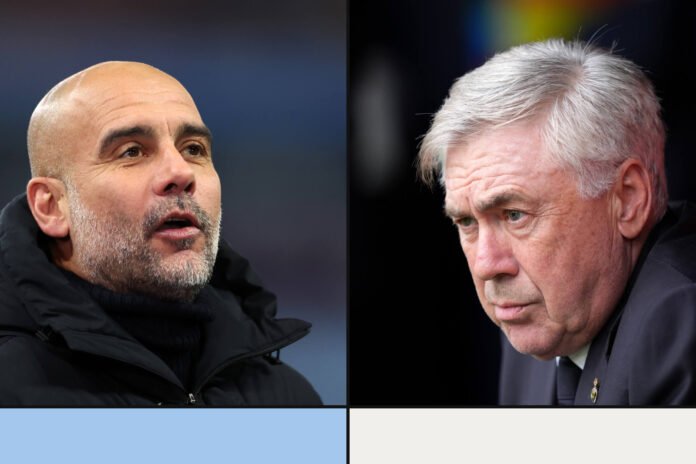If you were asked to devise an archetypal Champions League match for someone who had never previously witnessed European football, there’s a good chance that your two managers would be Pep Guardiola and Carlo Ancelotti. Guardiola versus Ancelotti, more than any other possible combination, is pure Champions League.
Guardiola and Ancelotti are two of only four managers to ever win (at least) three European Cups as a manager, alongside Bob Paisley and Zinedine Zidane. And while Paisley and Zidane achieved their hat-tricks with one club — Liverpool and Real Madrid — this duo cover more of the continent.
Guardiola has won two with Barcelona and one with Manchester City, Ancelotti has won two apiece with AC Milan and Real Madrid. That doesn’t take into account Guardiola’s three semi-finals with Bayern Munich either, or Ancelotti’s history in this competition with Parma, Juventus, Chelsea, Paris Saint-Germain, Bayern and Napoli. They are the two coaches with the most Champions League wins as managers overall. Oh, and they also both won the European Cup as players too.
The funny thing is that it’s a rivalry almost purely based in continental competition. They’ve only simultaneously managed in the same league once, when Ancelotti had an 18-month spell in charge of Everton, whom he guided to mid-table. In other words, they’ve never been fighting against each other for a title, so no genuine rivalry has emerged.
Everton vs City was a rare domestic meeting between Ancelotti and Guardiola (Laurence Griffiths – The FA/The FA via Getty Images)
The interesting thing about their relationship is that, whereas once you would have put them together at one end of the spectrum in football’s ideological debate, now they seem very different. That’s partly because they have changed, but it’s more because the debate has changed.
Back in the 2000s, European football was largely defensive, concerned with shape, structure and sporadic counter-attacking. Jose Mourinho and Rafa Benitez felt like the managers who defined the Champions League at that point.
In contrast, Ancelotti’s Milan side felt like outliers. He was desperate to accommodate as many midfield playmakers as possible — at a time when others went for destroyers and playmakers. Ancelotti fielded Andrea Pirlo, Clarence Seedorf and Kaka in the same diamond midfield, and sometimes used Rui Costa and turned it into a Christmas tree.

Ancelotti with the Champions League trophy after Milan’s win in 2007 (Alex Livesey/Getty Images)
When Guardiola was interviewed by The Times of London in 2004, he lamented the absence of deep playmakers in the game — there were barely any midfielders who reminded him of his own playing style. “The only one I see today is Pirlo,” he said. Guardiola had once been Pirlo’s replacement. The Italian had been converted into a deep midfielder, when previously regarded as a No 10, during a loan spell at Brescia. When Pirlo moved onto Milan, Brescia brought in Guardiola to play that deep role.
And when Guardiola became a manager, of course, he set about redressing the balance and popularising the concept of passing midfielders. Xavi and Andres Iniesta, fresh from winning Euro 2008 with Spain, reached new heights. Sergio Busquets was groomed by Guardiola as the Guardiola figure, playing in front of the defence. Without an energetic destroyer in the mould of Gennaro Gattuso, Guardiola’s Barcelona midfield was even more technical than Ancelotti’s Milan midfield. The two managers who most kept alive the concept of deep playmakers — and possession football overall — were these two.
That vision effectively won the day. Now, almost every top side is insistent on dominating possession. Things have moved on; pressing has been repopularised, although that’s partly to regain possession as quickly as possible. Whichever way you look at it, every good side is expected to retain possession and attempt to dominate the game. Deep defending and countering is, at the top level, almost dead as a default strategy.

Guardiola, last June, with the third Champions League of his managerial career (Franck Fife/AFP via Getty Images)
Now the debate is less about whether you want to dominate possession, and more about the level of freedom given to the players. Guardiola’s emphasis on positional play in attack is obvious, and his Manchester City side have been defined as much by set patterns of play as by the brilliance of individuals. You think of wingers crossing for each other to finish at the far post, or City’s players dragging opponents apart to create space for Kevin De Bruyne to burst into.
There’s a familiarity about City’s attacking play — that doesn’t mean it’s easy to stop but some neutrals have begun to tire of it, especially now Guardiola’s side is based around a penalty-box striker, Erling Haaland, who needs service.
It’s tempting to ask what 2024-era Guardiola would do if he had a talent such as Lionel Messi at his disposal. He gave Messi freedom to express himself and roam around as he pleased at Barcelona but that was a decade ago, and Guardiola’s approach has seemingly become even stricter: there are even more constraints for his attackers.
It’s surprising how often City’s attacking players, seemingly often in the form of their life, are content to leave the club. There’s a sense that they want to discover some level of fun. Jack Grealish has been turned from an unpredictable box of tricks into something more functional — and while he’s not the first to undergo that type of transformation, it’s arguable whether he’s actually any more efficient.
Ancelotti allows his players more freedom, although the interesting thing is the extent to which he performed a U-turn. His early coaching days were about a strict 4-4-2 with very rigid, defined roles for attackers. This was more about their game without possession rather than with it, but Ancelotti famously sold Gianfranco Zola and turned down the option of signing Roberto Baggio at Parma because he couldn’t accommodate a No 10 in his system. “I was Ancelotti, the anti-imagination,” he once recalled.
Ancelotti’s dramatic re-think came when he coached Zidane at Juventus and realised a player of that quality needed freedom from a system. It didn’t always get the best from Zidane, or his team-mates. Indeed, Zidane’s freedom was more suited to his playing days at the Galacticos in Madrid, and while that precise era was ultimately underwhelming, it helped create a spirit that has lived on: an emphasis upon individuals being empowered.
Madrid are more about players than managers and, sure enough, Zidane and Ancelotti, each in two spells as manager, have proved perfect because they don’t micromanage too much.

Jude Bellingham has thrived under Ancelotti’s management (Gonzalo Arroyo Moreno/Getty Images)
Ancelotti’s Madrid are not as cohesive as Guardiola’s City. But in Vinicius Junior, Rodrygo and Jude Bellingham, they have three players who can turn a match single-handedly with a moment of magic, probably more so than any of City’s players can, with respect to De Bruyne and the in-form Phil Foden. There is more alternating of positions in attack, more examples of players popping up where no one expects them.
This will be the third straight season these managers have met in the Champions League knockout stage. Ancelotti’s Madrid prevailed 6-5 on aggregate in a mad, end-to-end tie two years ago, while Guardiola’s City were comfortable 5-1 winners last season. That tallies with the sense of the difference between these two: Ancelotti’s sides are better at improvising, Guardiola’s have learned how to follow a very particular (and very successful) script.
(Top photos: Getty Images)
Read the full article here


